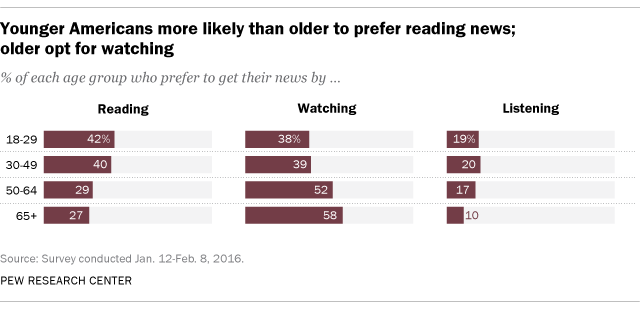
When it comes to technology’s influence on America’s young adults, reading is not dead – at least not the news. When asked whether one prefers to read, watch or listen to their news, younger adults are far more likely than older ones to opt for text, and most of that reading takes place on the web.
Overall, more Americans prefer to watch their news (46%) than to read it (35%) or listen to it (17%), a Pew Research Center survey found earlier this year. But that varies dramatically by age. Those ages 50 and older are far more likely to prefer watching news over any other method: About half (52%) of 50- to 64-year-olds and 58% of those 65 and older would rather watch the news, while roughly three-in-ten (29% and 27%, respectively) prefer to read it. Among those under 50, on the other hand, roughly equal portions – about four-in-ten of those ages 18-29 and ages 30-49 – opt to read their news as opt to watch it.
 Most of that reading among younger adults is through digital text rather than print. About eight-in-ten (81%) of 18- to 29-year-olds who prefer to read their news also prefer to get their news online; just 10% choose a print newspaper. The breakdown among 30- to 49-year-olds is similar. News readers who are ages 50-64, on the other hand, are more evenly split between a preference for the web (41%) and print paper (40%), while those 65 and older mostly still turn to the print paper (63%).
Most of that reading among younger adults is through digital text rather than print. About eight-in-ten (81%) of 18- to 29-year-olds who prefer to read their news also prefer to get their news online; just 10% choose a print newspaper. The breakdown among 30- to 49-year-olds is similar. News readers who are ages 50-64, on the other hand, are more evenly split between a preference for the web (41%) and print paper (40%), while those 65 and older mostly still turn to the print paper (63%).
There is also evidence that younger adults who prefer to watch their news are beginning to make the transition to doing so on a computer rather than a television. While 57% of 18- to 29-year-old news watchers prefer to get their news via TV, 37% cite the web as their platform of choice. That is far more than any other age group, including double the percentage of 30- to 49-year-old news watchers.
While news listening garners a smaller fan base overall, 18- to 29-year-olds who prefer this method of news again show signs of digital migration: Three-in-ten of these news listeners prefer the web for their news, at least twice that of older news listeners.
To be sure, younger adults consistently demonstrate less interest in the news overall. But our research also reveals that, in the digital realm, they often get news at equal or higher rates than older Americans, whether intentionally or not.



